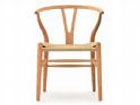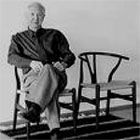Design Classics
Wishbone Chair, 1950
Designer: Hans J. Wegner
Manufacturer: Carl Hansen & Son


Some modern furniture designers began as architects, others as interior or industrial designers. Surprisingly, few started as craftsmen. Hans J. Wegner, the Danish designer, is one designer whose work is firmly rooted in his early training and life-long dedication to the tradition of fine cabinetmaking. Together with his fellow designers Arne Jacobsen, Finn Juhl and Poul Kjaerhold, Wegner made Denmark the epicentre of furniture design after the Second World War. On April 2, 2005, Wegner celebrated his 91st birthday.
WHAT
Wegner was fascinated by period furniture. The Wishbone chair (also known as the Y Chair) is one of several chairs inspired by 19th-century portraits of stolid Danish merchants sitting in Chinese chairs of the Ming Dynasty. This less rigid version of its Chinese inspiration has a unified curved wooden back and arm, slightly splayed legs and a canted seat made from woven paper cord. A classic soaped finish imbues the wood surface with a matte finish that begs to be stroked. And while much of the chair is machine made, his chairs still require considerable handwork to laminate and hand saw the pieces to shape, and to weave the seat.
WHY
The handcrafted process and tactile surfaces of the Wishbone chair appeal to our basic need for authenticity and sensuality. Respect of its Chinese ancestry gives it a foot in the past while Wegner’s reinterpretation makes for an organic form that, unlike some modern design, connects to the body. As Wegner says “a chair is not a chair until someone sits in it.” More than 500,000 Wishbone chairs have been sold; they are in the collection of major museums including 100 in the Museum of Modern Art in New York.
Wegner summed up his no-nonsense design philosophy in his hope that “...people will not be drawn to novelty, but will learn to value what is simple and pure in good design, that things should do the job they are designed for.”
National Post, November 3, 2005.
